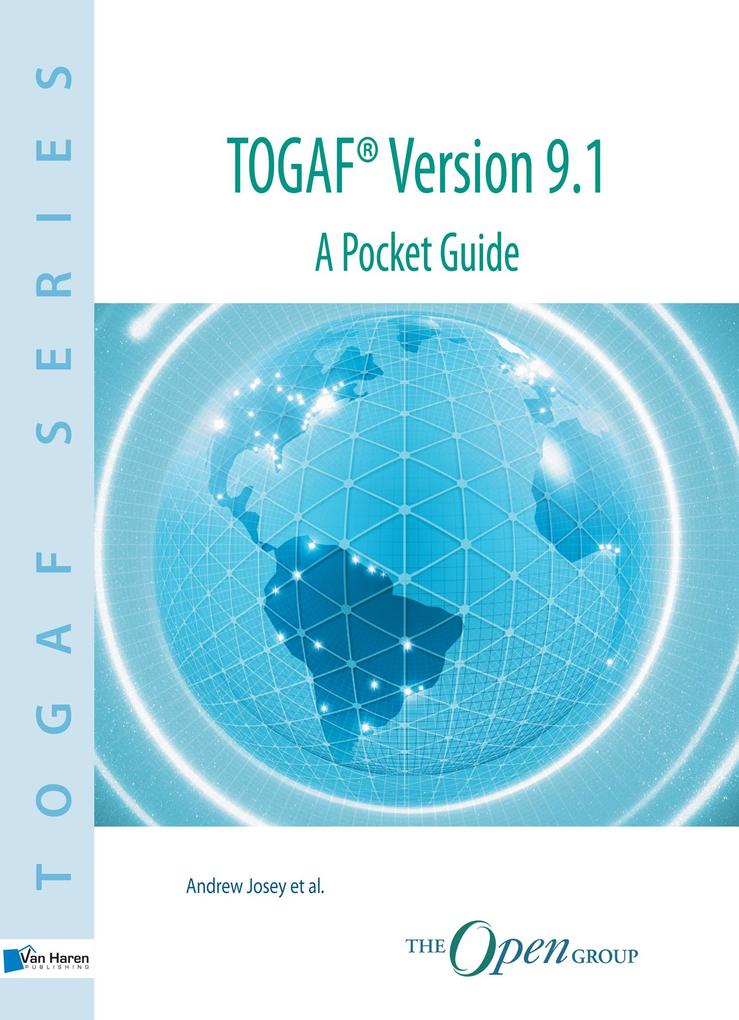
Sofort lieferbar (Download)
Note: This book is available in several languages: Brazilian Portuguese, English, Spanish, French.
This is the official Open Group Pocket Guide for TOGAF Version 9. 1 and is published in hard copy and electronic format by Van Haren Publishing on behalf of The Open Group. TOGAF®, an Open Group Standard, is a proven enterprise architecture methodology and framework used by the worlds leading organizations to improve business efficiency. It is the most prominent and reliable enterprise architecture standard, ensuring consistent standards, methods, and communication among enterprise architecture professionals. Enterprise architecture professionals fluent in TOGAF standards enjoy greater industry credibility, job effectiveness, and career opportunities. TOGAF helps practitioners avoid being locked into proprietary methods, utilize resources more efficiently and effectively, and realize a greater return on investment.
This is the official Open Group Pocket Guide for TOGAF Version 9. 1 and is published in hard copy and electronic format by Van Haren Publishing on behalf of The Open Group. TOGAF®, an Open Group Standard, is a proven enterprise architecture methodology and framework used by the worlds leading organizations to improve business efficiency. It is the most prominent and reliable enterprise architecture standard, ensuring consistent standards, methods, and communication among enterprise architecture professionals. Enterprise architecture professionals fluent in TOGAF standards enjoy greater industry credibility, job effectiveness, and career opportunities. TOGAF helps practitioners avoid being locked into proprietary methods, utilize resources more efficiently and effectively, and realize a greater return on investment.
Inhaltsverzeichnis
1;Preface;10 2;Trademarks;15 3;About the Authors;16 4;Acknowledgements;19 5;Chapter 1 Introduction;20 5.1;1.1 Introduction to TOGAF;20 5.2;1.2 Structure of the TOGAF Document;21 5.3;1.3 What is Architecture in the Context of TOGAF?;22 5.4;1.4 What kinds of Architecture does TOGAF deal with?;22 5.5;1.5 What does TOGAF Contain?;23 6;Chapter 2 The Architecture Development Method;28 6.1;2.1 What is the ADM?;28 6.2;2.3 The ADM in Detail;32 6.3;2.4 Scoping the Architecture Activity;45 7;Chapter 3 Key Techniques and Deliverables of the ADM Cycle;48 7.1;3.1 Tailored Architecture Framework;50 7.2;3.2 Organizational Model for Enterprise Architecture;51 7.3;3.3 Architecture Principles;52 7.4;3.4 Business Principles, Business Goals, and Business Drivers;57 7.5;3.5 Architecture Repository;57 7.6;3.6 Architecture Tools;58 7.7;3.7 Request for Architecture Work;58 7.8;3.8 Statement of Architecture Work;59 7.9;3.9 Architecture Vision;59 7.10;3.10 Stakeholder Management;60 7.11;3.11 Communications Plan;63 7.12;3.12 Business Transformation Readiness Assessment;64 7.13;3.13 Capability Assessment;64 7.14;3.14 Risk Management;66 7.15;3.15 Architecture Definition Document;67 7.16;3.16 Architecture Requirements Specification;70 7.17;3.17 Architecture Roadmap;72 7.18;3.18 Business Scenarios;74 7.19;3.19 Gap Analysis;75 7.20;3.20 Architecture Viewpoints;77 7.21;3.21 Architecture Views;79 7.22;3.22 Architecture Building Blocks;80 7.23;3.23 Solution Building Blocks;81 7.24;3.24 Capability-Based Planning;82 7.25;3.25 Migration Planning Techniques;83 7.26;3.26 Implementation and Migration Plan;87 7.27;3.27 Transition Architecture;88 7.28;3.28 Implementation Governance Model;89 7.29;3.29 Architecture Contracts;89 7.30;3.30 Change Request;91 7.31;3.31 Compliance Assessment;92 7.32;3.32 Requirements Impact Assessment;93 8;Chapter 4 Guidelines for Adaptingthe ADM;94 8.1;4.1 Introduction;94 8.2;4.2 Applying Iteration to the ADM;96 8.3;4.3 Applying the ADM across the Architecture Landscape;102 8.4;4.4
Security Architecture and the ADM;103 8.5;4.5 Using TOGAF to Define and Govern SOAs;105 9;Chapter 5 Architecture Content Framework;108 9.1;5.1 Architecture Content Framework Overview;108 9.2;5.2 Content Metamodel;109 9.3;5.3 Architectural Artifacts;113 9.4;5.4 Architecture Deliverables;117 9.5;5.5 Building Blocks;117 10;Chapter 6 The Enterprise Continuum;120 10.1;6.1 Overview of the Enterprise Continuum;120 10.2;6.2 Architecture Partitioning;123 10.3;6.3 Architecture Repository;124 11;Chapter 7 TOGAF Reference Models;128 11.1;7.1 TOGAF Foundation Architecture;128 11.2;7.2 Integrated Information Infrastructure Reference Model (III-RM);128 12;Chapter 8 Architecture Capability Framework;130 12.1;8.1 Establishing an Architecture Capability;132 12.2;8.2 Architecture Governance;132 12.3;8.3 Architecture Board;133 12.4;8.4 Architecture Compliance;134 12.5;8.5 Architecture Skills Framework;134 13;Appendix A Migration Summary;138 14;Glossary;152 15;Index;158
Security Architecture and the ADM;103 8.5;4.5 Using TOGAF to Define and Govern SOAs;105 9;Chapter 5 Architecture Content Framework;108 9.1;5.1 Architecture Content Framework Overview;108 9.2;5.2 Content Metamodel;109 9.3;5.3 Architectural Artifacts;113 9.4;5.4 Architecture Deliverables;117 9.5;5.5 Building Blocks;117 10;Chapter 6 The Enterprise Continuum;120 10.1;6.1 Overview of the Enterprise Continuum;120 10.2;6.2 Architecture Partitioning;123 10.3;6.3 Architecture Repository;124 11;Chapter 7 TOGAF Reference Models;128 11.1;7.1 TOGAF Foundation Architecture;128 11.2;7.2 Integrated Information Infrastructure Reference Model (III-RM);128 12;Chapter 8 Architecture Capability Framework;130 12.1;8.1 Establishing an Architecture Capability;132 12.2;8.2 Architecture Governance;132 12.3;8.3 Architecture Board;133 12.4;8.4 Architecture Compliance;134 12.5;8.5 Architecture Skills Framework;134 13;Appendix A Migration Summary;138 14;Glossary;152 15;Index;158
Mehr aus dieser Reihe
Produktdetails
Erscheinungsdatum
01. Januar 2016
Sprache
englisch
Seitenanzahl
136
Dateigröße
2,56 MB
Reihe
TOGAF Series
Autor/Autorin
Andrew Josey
Verlag/Hersteller
Kopierschutz
mit Adobe-DRM-Kopierschutz
Family Sharing
Ja
Produktart
EBOOK
Dateiformat
EPUB
ISBN
9789087539672
Entdecken Sie mehr
Bewertungen
0 Bewertungen
Es wurden noch keine Bewertungen abgegeben. Schreiben Sie die erste Bewertung zu "TOGAF® Version 9.1 - A Pocket Guide" und helfen Sie damit anderen bei der Kaufentscheidung.








